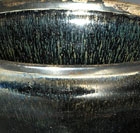J.J. Lally & Co., Oriental Art / New York City, New York
MenuPast Exhibition
Early Chinese Ceramics: An American Private Collection
March 28 - April 16, 2005
23.
A BLACK-GLAZED JIANYAO ‘HARE’S FUR’ TEABOWL (YANKOU WAN)
Song Dynasty (A.D. 960–1279)
with steep flaring sides cut at an angle above the thick ring foot, and with a concave ‘finger-groove’ beneath the rim, covered with a lambent bluish-black glaze suffused with fine silver fur-like streaks converging towards the center on the interior and draining down from the lip on the exterior, the glaze coagulating in a thick roll around the angle near the base, the foot left unglazed revealing the dark purplish stoneware body, the mouth rim with a silver mount.
Diameter 4 3⁄4 inches (12.1 cm)
Ex. Collection Mrs. Samuel T. Peters, New York, no. 215.
A Jianyao teabowl of this classic form showing the same silvery ‘hare’s-fur’ markings, from the collection of the Metropolitan Museum of Art, is illustrated by Mowry in Hare’s Fur, Tortoiseshell and Partridge Feathers: Chinese Brown-and Black-Glazed Ceramics, 400–1400, Cambridge, 1996, pp. 219–220, no. 83, attributed by the author to the kilns at Shuiji, Jianyang county, Fujian province. Compare also the similar example from the Percival David Foundation, London, also with a silver mount on the rim, illustrated by Medley in The Chinese Potter, Oxford, 1976, p. 163, fig. 123.
Another black-glazed ‘hare’s fur’ Jianyao teabowl with silver-mounted rim is illustrated by Wu Tung in Earth Transformed: Chinese Ceramics in the Museum of Fine Arts, Boston, Boston, 2001, pp. 72–73, dated to the Northern Song Dynasty, 12th century by the author who points out that this type of teabowl was favored by the emperor Huizong (r. 1101–1125) who was a great connoisseur of tea and wrote famous treatises on the subject. In the opinion of the emperor and other tea connoisseurs of the Song period, the dark ‘hare’s-fur’ glazed teabowls were particularly beautiful when filled with the frothy light-colored tea drunk in that period.
宋 建窯黑釉兔毫紋碗 徑 12.1 厘米
